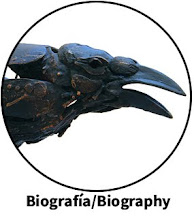
Orphans in Acebuche,
Mixed media on wood, 126x46 cm.
In this work I experimented with textures; not only tactile ones- I stuck some sand and blades of grass and poured some oil drops on the wood- but also visual textures, by using different objects to apply the oil painting: clothes, paint rollers, paintbrushes...
I painted it for an exhibition commemorating the 10th anniversary of the toxic dumping in Aznalcóllar Mines. It was held at the `Pavilion for Future ´in Seville in 2008. The exhibition was organized by the Spanish Association of Artists for Nature.

Orphans in Acebuche (Detail)
Part of the process of creation, graphite pencil drawing.

Orphans in Acebuche(Detail)
Sample of textures

Orphans in Acebuche(Detail)
`Within´ the shadow I wrote the following text:
NATURAL DISASTER IN AZNALCÓLLAR
On Saturday, April 25th, 1998, at 3.20 a.m., at the head of nesting and breeding birds, the dike of a raft containing 8 hm3 of toxic waste broke. This waste came from the mine dedicated to iron pyrite ( FeS2) extraction which Boliden-Apirsa, a Swiss-capital enterprise, had in Aznalcóllar.
The toxic dumping, of about 4,5 hm3, was mainly composed of very low PH liquids-high acidity(3,6 hm3)- and sludge with high concentrations of heavy metals (0,9 hm3). It went directly into the River Agrio and, from this, quickly to the River Guadiamar, which flows into the Natural Reserve of Doñana.
The acid flood rushed down the rivers, along 40 km for sludge and 10 more for the liquids, which burst its banks to 400 metres wide. The sludge reached an average thickness of 8cm, though in some places it got to 1,5 metres.
The dumping occupied an area of 4402 hectares (10877,578 acres), directly affecting the 520 miners in the mining company and about 500 farmers of the river banks. Crops and cattle, worth about 10.8000.000 Euros, were destroyed.
The first interventions that were made at the zone were to build a retaining wall in the Guadiamar near Isla Mayor, and divert its course through a canal to the Guadalquivir for the sludge that drag the seasonal rains went towards the Atlantic Ocean instead of Doñana.
Unfortunately, the contaminated water bathed the area known as `El Lucio del Cangrejo´, an area of great richness of bird life, where many bird species were nesting, some of them endangered.
On April 29th , the group `Environmental Volunteers for Doñana´ began activities in situ.
About 720 eggs and 15 chicks were rescued. We removed about 23 complete nests. Eggs and chicks were taken to the Breeding in Captivity Centre in Acebuche-between El Rocío and Matalascañas- where they proceed to their incubation and breeding. Most eggs belonged to: Avocets -Recurvirostra avosetta-, Stilts – Himantopus sp (540), Purple Heron – Ardea Purpurea (95)-, Mallards- Anas platyrhynchos (65)-, Marbled ducks –Marmaronetta angustirostris (in a nest I found), Gull-billed Tern – Sterna nilotica-, Common Coot –Fulica atra-, Purple Swamp-hen –Porphyrio alleni-, and Little Bittern –Ixobrychus minutus.
Together with the eggs of avocets and stilts, a chick of Little Ringed Plover –Charadrius dubius- was born. Besides we had three chicks of Marsh Harrier –Circus aeruginosus.
We looked after the chicks from the first weeks of May until August of that year. I went almost every weekend and whenever I was able to on holidays.
Almost all the avocets and stilts were killed by a bacterium which caused them ulcers in their beaks. Some fellow volunteers forgot to put the antibiotic (which prevented the spread of parasites and viruses) in the water, . `Chiquito´, the Little Ringed Plover died, too, the same as the Marsh Harriet chicks. Everything happened in only three days.
We put them in the sun from 10 to 12, but, a day we forgot to take them away and the three died of sunstroke. In the end 80% of Purple Herons and anatidae survived. But only the chicks of six Marbled Duck, one Purple Swamp-hen, and one Little Bittern survived.














